
Archives & Manuscripts Costumes & Textiles Daguerreotypes & Photographs Decorative Arts Fine Art Other Collections Furniture Digital Collections 
|


Bead-Knitted Bags
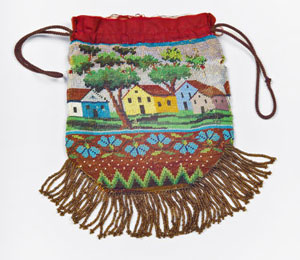 |
Three panel bead-knitted bag, circa 1825 Photograph by Stan Sherer |
This bead-knitted bag from the collection of Historic Northampton was featured in the article, “Three-Paneled Bead-Knitted Bags of Nineteenth-Century New England,” by R. Lee Forsythe in Piecework Magazine’s Knitting Traditions (fourth edition, 2012). Forsythe examined bead-knitted bags made by hand during the first half of the nineteenth-century in the collections of twelve New England museums. Bead-knitted bags of the period commonly have designs divided into three panels or bands. This bag, dating to 1825, features a pictorial scene of houses in the center panel and vines and flowers in the bottom panel. The designs were created by carefully stringing tiny colored glass beads on thread in a predetermined order and then knitting a bead with each stitch, creating a beaded fabric. Once the bead-knitted fabric was created it was finished with a protective lining. The dark red silk lining sewn to the beaded fabric shown above is possibly original. The bag was donated to Historic Northampton by a “Mrs. Thayer.”
The designs of the bead-knitted bags in the collection of Historic Northampton reflect the variety of designs Lee Forsythe encountered in the eleven other New England museum collections.
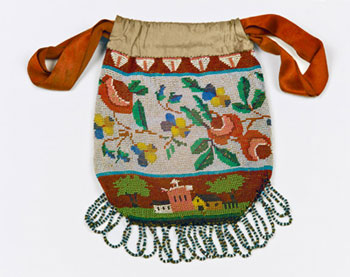 |
Three panel bead-knitted bag, circa 1825-1850 Photograph by Stan Sherer |
Flowers: "The rose as a central-panel motif shows up in every collection that I examined; most were worked in a light and dark shade of red, pink, and white beads. Another common flower is the pansy, worked with a light and dark shade of blue and yellow and sometimes with an accent of red. Other flowers include forget-me-nots, morning glories, lilies, yellow or blue daisies...." Shown at right is a circa 1825-1850 bead-knitted bag with a rose and pansy center panel, a landscape scene of buildings and trees in the lower panel and a three-color geometric design in the upper panel. Forsythe found that "clusters of generic buildings and trees fill many lower panels." The 6 3/4" x 5 3/4" bag (excluding fringe) was knitted with yellow silk thread and lined with white cotton. The beige silk top is likely a replacement as is the 1 5/8" ribbon tie which dates to the 1880s. The maker, history of ownership and donor of the bag are unknown.
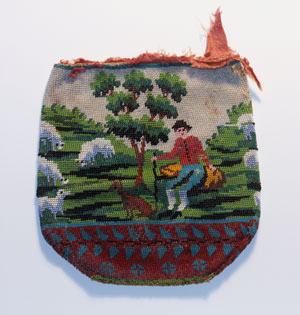 |
Genre scene of a shepherd and his flock Photograph by Shannon Ryan |
Genre scenes: "Genre scenes such as children floating boats, Mary and her lamb at school, men rowing boats, hunting scenes, and a shepherd with his flock are common." The center panel of the bead-knitted bag at left features a shepherd seated on a rock with a dog and grazing sheep. In the lower panel is a blue and black leaf vine followed by a blue pinwheel design with burgundy beads in the negative space. The beads were knitted with yellow silk. The bag is lined with heavy linen in a satin-like weave. The fragmentary pink silk top has a woven floral figure. The bag was donated by Miss Sara Bottum.
Another pastoral scene in Historic Northampton's collection may depict Mary with her lamb at school. Forsythe found the scene of Mary with her lamb as a center panel design on three different bags. In the bottom panel is a foliate design. The beads were knitted with pale yellow silk. The original lining appears to have been leather or suede faced toward the beaded fabric with white linen. The bag was relined with silk circa 1900 and with a new drawstring. The bag was donated from the estate of Thomas and Edith Shepherd.
Landscapes: Forsythe found designs with "neoclassical themes of castles, turrets and Greek-inspired public buildings and villages" common. Several bead-knitted bags in the collection of Historic Northampton depict landscapes and scenes of buildings ranging from generic buildings to buildings with distinctive architectural features.
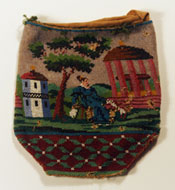 |
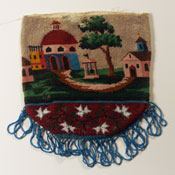 |
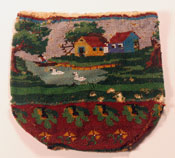 |
The center panels of the bead-knitted bags at left and at center feature fanciful buildings with domed tops amid a green landscape with a single leafy tree worked in shades of green. At right, two white ducks swim in a blue pond amid a grassy landscape with two buildings on the horizon.
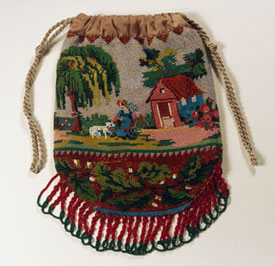 |
This bead-knitted bag may depict Mary with her lamb at school. Photograph by Shannon Ryan |
Unlike samplers and woven bead chains, the makers of the bead-knitted bags in the collection of Historic Northampton are not clearly identified on the bag itself or through associated notes. "I found little mention of bead-knitted bags in diaries of the period," Forsythe found.
The main primary source about bead-knitted bag construction and patterns Forsythe encountered were needlework handbooks of the period such as The Ladies Work Table Book (1847), The Ladies Complete Guide to Needlework, Embroidery, and Beadwork (1859) and the 1850s American editions of Frances S. Lambert's handbooks.
As part of her research, Forsythe "looked for evidence that materials or finished bags were sold in rural general stores, but inventories of more than fifty stores yielded no references to either beads or beaded bags." Forsythe suggested that perhaps beads or finished bags were purchased or obtained by barter from itinerant peddlers. As an example, Forsythe notes that M.P. Barker while an interpreter at Old Sturbridge Village, discovered that in 1839 and 1840, William M. Sanderson, a young man working for Jasper Bement of Ashfield, Massachusetts, peddled twenty-one beaded bags for $1.00 each. He also sold beads and sewing silk.
Contents Historic Northampton.